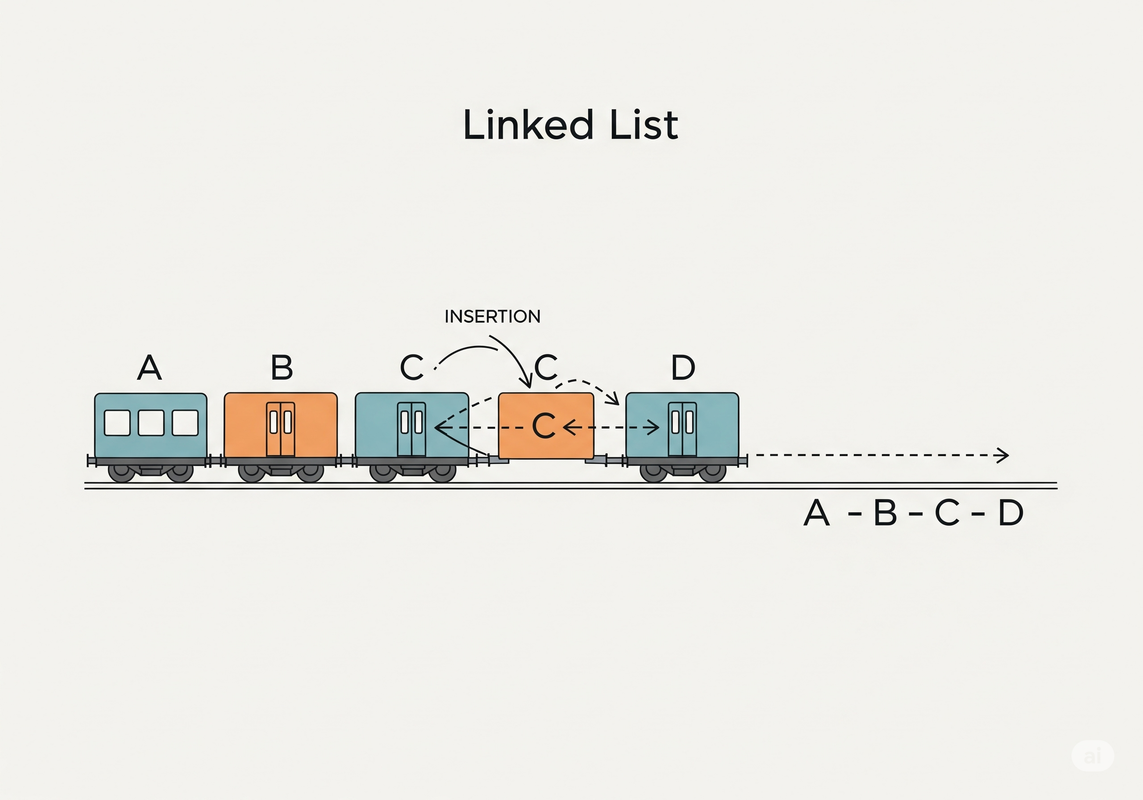Blueprint 4: "Forging the Data Chain" ⛓️
1. The Mission Briefing: A Rigid Problem
"Architect, our 'Data Crystals' (Arrays) are rigid and stored in one solid block. If we need to insert a new piece of data in the middle of a critical sequence, we have to move every single item after it. This is highly inefficient and causes system-wide lag. We need a more flexible, chain-like structure."
This is a classic engineering problem. An Array is fantastic for its fast access time—if you know an item's address (its index), you can get it instantly. But this speed comes at a cost: inflexibility. Adding or removing something from the middle of an array is like trying to add a new house in the middle of a street where all the houses are built right next to each other. You'd have to tear down and rebuild half the street!
We need a better tool for dynamic data.
2. The Analogy: The Train Cars
A Linked List is like a train. Each car (a Node) is its own separate object, but it holds a 'coupler' (a pointer) that links it to the next car in the sequence.
Imagine you have a train with cars labeled A, B, and D. If you need to add car C between B and D, you don't have to rebuild the whole train. You simply:
- Unhook the coupler between B and D.
- Connect B's coupler to C.
- Connect C's coupler to D.
The train is now A-B-C-D. This operation was incredibly fast and didn't disturb car A at all. This is the core strength of a Linked List.

3. The Logic: How Memory is Allocated
The "Train Car" analogy works because of how Linked Lists use computer memory. Unlike an array, the nodes of a linked list can be scattered all over memory. They don't need to be side-by-side.
Array: Rigid & Contiguous
[ Block 0 ][ Block 1 ][ Block 2 ]
Linked List: Flexible & Scattered
[ Node A ] ---> [ Node B ] ---> [ Node C ]
This visual directly explains the core trade-off: In a Linked List, insertion and deletion are incredibly fast (O(1) if you're at the right spot), but accessing the 100th element requires you to travel through the first 99 links (O(n)).
4. The Building Block: The Node
Every chain is made of links, and in our data structure, every link is a Node. A node is a simple container with two parts:
- Data: The actual information we want to store (e.g., a number, a string, a user object).
- Pointer (or next): The "coupler." It's a reference that points to the memory address of the very next node in the sequence. The last node in the chain points to null to signify the end.
Code Example: A Node Blueprint
class Node:
def __init__(self, data, next_node=None):
self.data = data
self.next = next_node5. The Structure: The LinkedList Class
The LinkedList class itself is the "station master." It doesn't need to know where every single train car is. It only needs to keep track of one crucial piece of information: the very first node in the chain, which we call the head.
Code Example: A LinkedList Blueprint
class LinkedList:
def __init__(self):
self.head = None # A new, empty list has no head6. Core Operations: Step-by-Step
Let's see how the most common operations work, with flowcharts and code.
A. Traversal (Visiting Every Node)
This is how we read the contents of a linked list. The logic is simple: start at the head and follow the next pointers until you reach null.
Code Example: Traversal
class LinkedList:
# ... __init__ ...
def print_list_data(self):
current = self.head
while current:
print(current.data)
current = current.nextB. Insertion (Adding a New Node)
The beauty of linked lists is the efficiency of insertion, especially at the head of the list. It's a constant-time O(1) operation because it doesn't matter how long the list is; you only ever need to adjust the head pointer.
Interactive Linked List Simulation
Click the buttons below to see linked list operations in action and their time complexities.
List is empty
Code Example: Insertion at Head
class LinkedList:
# ... __init__ ...
def insert_at_head(self, data):
new_node = Node(data, self.head)
self.head = new_node7. Expanding the Blueprint: Types of Linked Lists
The basic "singly" linked list is just the beginning. Architects of the Labyrinth use more advanced versions.
A. Doubly Linked Lists
The Analogy: Imagine our train cars now have couplers on both ends. Each node has a pointer to the next node AND the previous node. The Benefit: You can traverse the list forwards and backwards! This is incredibly useful for features like a browser's back/forward history or an "undo/redo" function.
null <-- [A] <--> [B] <--> [C] --> nullB. Circular Linked Lists
The Analogy: Imagine a circular train track. The "last" car doesn't point to null; it links right back to the "first" car, forming a continuous loop. The Benefit: Useful for managing resources in a loop, like switching between applications in an operating system (round-robin scheduling) or turns in a game.
--> [A] -> [B] -> [C] -> [D] --
| |
-------------------------------
8. Blueprint Summary
Concepts Unlocked: Linked Lists, Nodes, Pointers, Non-Contiguous Memory, Time Complexity Trade-offs, Singly, Doubly, and Circular Linked Lists.